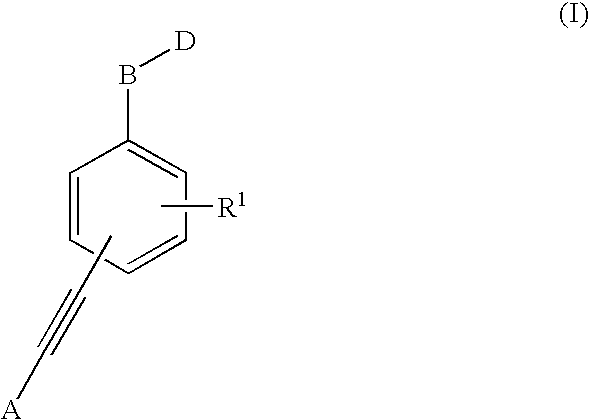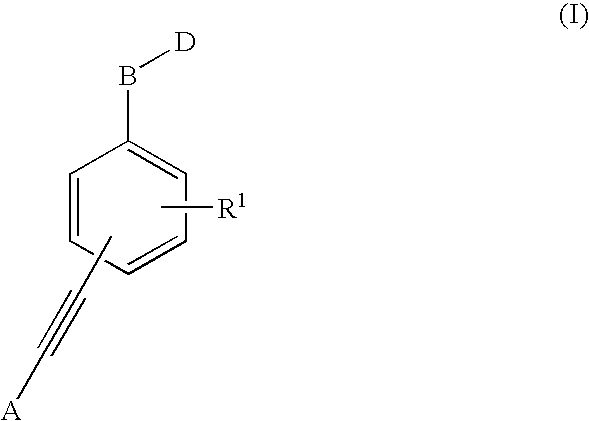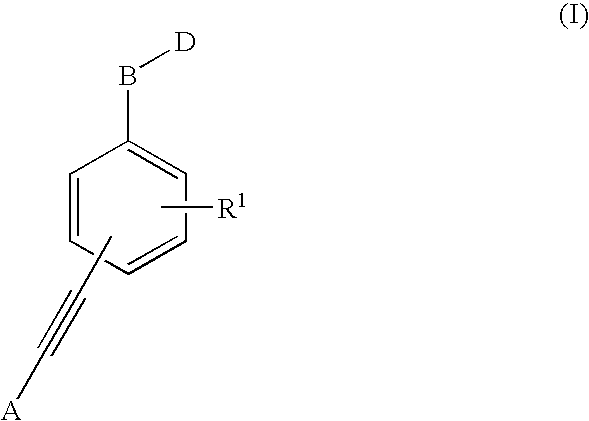1,1′-(1,2-ethynediyl)bis-benzene derivatives as PTP 1-B inhibitors
a technology of ethyl bisbenzene and derivatives, which is applied in the field of carboxylic acids, can solve the problems of increasing the risk of coronary heart diseas
- Summary
- Abstract
- Description
- Claims
- Application Information
AI Technical Summary
Benefits of technology
Problems solved by technology
Method used
Image
Examples
example 1
5-[{4-[(4-butylphenyl)ethynyl]benzyl}(hexyl)amino]-2-hydroxybenzoic acid N-methyl-D-glucamine (i.e. 1-deoxy-1-(methylamino)glucitol) salt
Step a) Formation of 2,2-dimethyl-6-nitro-4H-1,3-benzodioxan-4-one
[0347]
[0348]A mixture of 2-hydroxy-5-nitrobenzoic acid (Aldrich, 50.0 g, 0.27 mol), acetone (40 mL, 0.54 mol) and trifluoroacetic anhydride (TFAA) (Aldrich, 100 mL, 0.71 mol) in trifluoroacetic acid (TFA) (Aldrich, 300 mL) was heated at reflux. After 1 hour, an additional amount of acetone (60 mL, 0.82 mol) was added and the resulting reaction mixture was heated under reflux for an additional 48 hrs. The reaction mixture was concentrated under reduced pressure. The residual brown solid was dissolved in DCM (800 mL) and washed with a mixture of an aqueous saturated solution of NaHCO3 (400 mL) and water (400 mL). The aqueous layer was extracted with DCM (2×400 mL). The combined organic layers were dried over MgSO4 and the solvent was removed under reduced pressure. The residual brown o...
example 2
5-[{4-[(4-butylphenyl)ethynyl]benzyl}(hexyl)amino]-2-hydroxybenzoic acid hydrochloride salt
[0361]
[0362]To a solution of 6-[{4-[(4-butylphenyl)ethynyl]benzyl}(hexyl)amino]-2,2-dimethyl-4H-1,3-benzodioxin-4-one (240 mg, 8.4 mmol) in EtOH (15 mL) and water (1 mL) was added an aqueous solution of NaOH (0.5 mL, 5N). The reaction mixture was heated under reflux for 2 hrs. Then an aqueous solution of HCl (2 mL, 5N) was added and the solvents were evaporated under reduced pressure to give a brown oil. The oil was taken up with water (10 mL) and extracted with Et2O (2×10 mL). The combined organic layers were dried over MgSO4 and the volume of solvent was half reduced under reduced pressure. Then a solution of HCl in Et2O (2 mL, 1M) was added and a beige solid precipitated out. The solid was filtrated off, washed with Et2O and dried under vacuum to give 155 mg (65%) of the title compound as a beige powder. HPLC, Rt: 4.7 min (purity: 99.7%). LC / MS, M−(ESI): 482.3. 1H NMR (CD3OD) δ: 7.87 (d, J=...
example 3
5-[{4-[(4-butylphenyl)ethynyl]benzyl}(hexyl)amino]-2-hydroxybenzoic acid, lysine salt
[0363]
[0364]To a solution of the 5-[{4-[(4-butylphenyl)ethynyl]benzyl}(hexyl)amino]-2-hydroxybenzoic acid (90 mg, 0.19 mmol) in freshly distilled THF (1 mL) was added a solution of L-lysine (Aldrich, 27 mg) in water (1 mL). Water (20 mL) was added and the resulting solution was lyophilized to give 87 mg (74%) of the title compound as a pale yellow powder. HPLC, Rt: 4.9 min purity: 99.4%). LC / MS, M+(ESI): 483.7, M−(ESI): 482.1.
PUM
| Property | Measurement | Unit |
|---|---|---|
| temperature | aaaaa | aaaaa |
| temperature | aaaaa | aaaaa |
| temperature | aaaaa | aaaaa |
Abstract
Description
Claims
Application Information
 Login to View More
Login to View More - R&D
- Intellectual Property
- Life Sciences
- Materials
- Tech Scout
- Unparalleled Data Quality
- Higher Quality Content
- 60% Fewer Hallucinations
Browse by: Latest US Patents, China's latest patents, Technical Efficacy Thesaurus, Application Domain, Technology Topic, Popular Technical Reports.
© 2025 PatSnap. All rights reserved.Legal|Privacy policy|Modern Slavery Act Transparency Statement|Sitemap|About US| Contact US: help@patsnap.com



